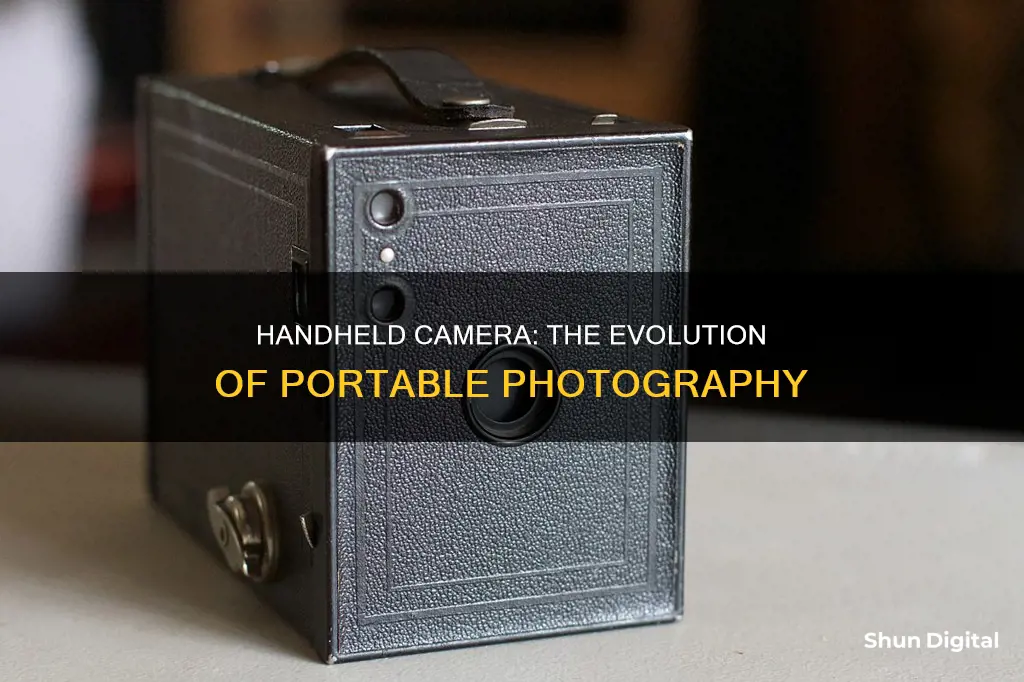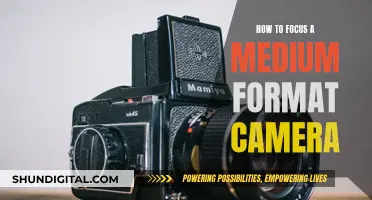
The history of the camera began long before the introduction of photography, with the camera obscura, a natural optical phenomenon named after its Latin translation, dark room. The first photographic camera was developed in the 18th and 19th centuries, and the first permanent photograph of a camera image was made in 1826 by Joseph Nicéphore Niépce. However, the first handheld camera was invented by George Eastman and placed on the market in 1888. It was a simple handheld box camera containing a 100-exposure roll of film and sold for $25. This invention revolutionised photography, making it accessible to millions of casual amateurs.
| Characteristics | Values |
|---|---|
| Year the first handheld camera was made | 1888 |
| Inventor | George Eastman |
| Company | Kodak |
| Camera name | Kodak #1 |
| Camera type | Simple handheld box camera |
| Film | 100-exposure roll of film |
| Film type | Paper negatives |
| Image type | Circular pictures |
| Image size | 2.5 inches (6 cm) in diameter |
| Camera price | $25 |
| Film processing | Sent back to the factory |
| Film processing cost | $10 |
What You'll Learn

The first handheld camera was the Kodak, invented by George Eastman in 1888
The Kodak was made possible by technical advances in the development of roll film and small, fixed-focus cameras. Eastman himself had been interested in photography since the 1870s, when he worked as a bank clerk. He developed a machine for coating dry plates in 1879 and, in 1881, he founded the Eastman Dry Plate Company with Henry Strong to sell plates. Around the same time, he began to experiment with creating a flexible film roll that could replace plates altogether. In 1885, he received a patent for a film roll and then focused on creating a camera to use the rolls.
Eastman also came up with the name "Kodak", believing that products should have their own identity, free from association with anything else. He coined the memorable slogan, "You press the button, we do the rest", which became ubiquitous in the general public. Within a few years of the Kodak's introduction, snapshot photography became a national craze. Various forms of the word "Kodak" entered common American speech, and amateur "camera fiends" formed clubs and published magazines to share their enthusiasm.
By 1927, Eastman Kodak had a virtual monopoly on the photographic industry in the United States, and it was one of the largest American companies in its field until the advent of digital photography in the late 20th century.
Altitude's Impact: Shorter Camera Battery Life Explained
You may want to see also

The Kodak camera used a 100-exposure roll of film
The first handheld camera, the Kodak, was invented by George Eastman and placed on the market in 1888. The Kodak was a simple box camera that came loaded with a 100-exposure roll of film. This was a significant innovation in the history of amateur photography as it simplified the apparatus and made photography accessible to millions of casual amateurs with no particular professional training, technical expertise, or aesthetic credentials.
The Kodak camera was sold for $25 with the film sealed inside. It used paper negatives instead of glass plates to take circular pictures, each roughly 2.5 inches (6 cm) in diameter. After the last negative was exposed, consumers sent the entire camera to one of the Eastman factories (in Rochester, New York, or Harrow, Middlesex, England), where the roll was processed and printed. The gelatin layer containing the image was stripped away after development and fixing and transferred to a transparent support.
In 1889, the paper film was replaced by film on a transparent plastic base of nitrocellulose that had been invented in 1887 by Hannibal Goodwin of Newark, New Jersey. Eastman reorganized his business as the Eastman Kodak Company in 1892. In 1900, Eastman introduced the Brownie, a simple $1 box camera featuring a removable film container so that the whole unit no longer needed to be sent back to the plant.
Charging Cameras While Streaming: A Guide to Power Sources
You may want to see also

The camera was sent back to the factory for developing and printing
The first handheld camera, the Kodak, was invented by George Eastman and placed on the market in 1888. It was a simple box camera that came loaded with a 100-exposure roll of film. The camera was sold for $25 with the film sealed inside. After the last negative was exposed, consumers sent the entire camera back to the factory in Rochester, New York, or Harrow, Middlesex, England. Here, the roll was processed and printed. The camera's distinctive circular snapshots defined a new style of photography—informal, personal, and fun.
The process of developing and printing involved several steps. Firstly, the gelatin layer containing the image was stripped away from the film after it had been developed and fixed. This gelatin layer was then transferred to a transparent support, creating a stable base for the photograph. The Eastman Kodak Company offered this service as part of their unique selling proposition, with Eastman coining the memorable slogan: "You press the button, we do the rest." This slogan emphasised the ease and convenience of the Kodak system, targeting casual amateurs without professional training or technical expertise.
The development and printing process was not instantaneous, and consumers had to wait for their photographs. Recognising the potential for impatience among his customers, Eastman offered an option for amateurs to finish their own pictures. Spare rolls of film were sold separately for $2, allowing enthusiasts to reload their cameras and continue taking pictures without having to send the camera back to the factory each time. This option granted photographers greater flexibility and encouraged experimentation with the new technology.
The Kodak camera revolutionised photography, making it accessible to the masses. Within a few years of its introduction, snapshot photography became a national craze in the United States. The camera's simplicity, combined with Eastman's marketing strategy, played a pivotal role in this transformation. Amateur photographers eagerly embraced the device, forming clubs and publishing magazines to share their passion. By 1898, just ten years after the Kodak's introduction, an estimated 1.5 million roll-film cameras were in the hands of amateur photographers.
Manual Mode: Mastering Close-Up Camera Focus
You may want to see also

The Kodak camera cost $25
The first handheld camera, the Kodak, was invented by George Eastman and introduced in 1888. It was a simple box camera that came loaded with a 100-exposure roll of film. The camera was sold for $25 with the film sealed inside. After the last negative was exposed, consumers sent the entire camera to one of the Eastman factories to be processed and printed. Eastman’s marketing strategy, which emphasised the camera's simplicity and ease of use, played a crucial role in its success. His famous slogan, "You press the button, we do the rest", highlighted the accessibility of photography for casual amateurs.
The Kodak camera's introduction marked a significant shift in the history of amateur photography. Within a few years, snapshot photography became a widespread phenomenon in the United States. The popularity of the Kodak camera led to the coining of new words and phrases, such as "kodaking", "kodakers", and "kodakery". Amateur photographers formed clubs and published magazines to share their passion for this new form of visual expression.
The Kodak camera's impact extended beyond casual photography. By 1898, just ten years after its introduction, an estimated 1.5 million roll-film cameras were in the hands of amateur photographers. This rapid adoption of the technology demonstrated the growing importance of photography as a means of personal documentation and creative expression.
The Kodak camera's influence on the art world was also significant. While some serious amateur photographers sought to elevate photography as a fine art form, others embraced the snapshot aesthetic, valuing the spontaneity and immediacy that the handheld camera afforded. This led to a reevaluation of vernacular photography, with anonymous snapshots from the late 19th and early 20th centuries eventually finding their place on the walls of major American art museums.
The $25 Kodak camera not only democratised photography but also shaped the way we capture and view the world around us, leaving a lasting impact on both popular culture and artistic movements.
The Evolution of Folding Cameras: A Historical Perspective
You may want to see also

The Kodak camera took circular pictures
The Kodak camera, introduced in 1888, was the first handheld camera to be widely adopted by the public. It was invented and marketed by George Eastman, a former bank clerk from Rochester, New York. The Kodak was a simple box camera that came loaded with a 100-exposure roll of film. When the roll was finished, the entire machine was sent back to the factory in Rochester, where it was reloaded and returned to the customer while the first roll was being processed. Eastman's marketing strategy was genius. By simplifying the apparatus and processing the film for the consumer, he made photography accessible to millions of casual amateurs with no particular professional training, technical expertise, or aesthetic credentials.
The earliest Kodak photographs were printed in this circular format, but later models produced a rectangular image, usually printed small enough to be held in the palm of the hand.
LG X Camera Specs: X Charge Edition
You may want to see also
Frequently asked questions
The first handheld camera was made in 1888 by George Eastman, who named it the Kodak.
The Kodak was a simple box camera that came loaded with a 100-exposure roll of film. The camera was sold for $25 with the film sealed inside. The Kodak produced circular images roughly 2.5 inches (6 cm) in diameter.
After the last negative was exposed, consumers sent the entire camera to one of the Eastman factories (in Rochester, New York, or Harrow, Middlesex, England), where the roll was processed and printed.







